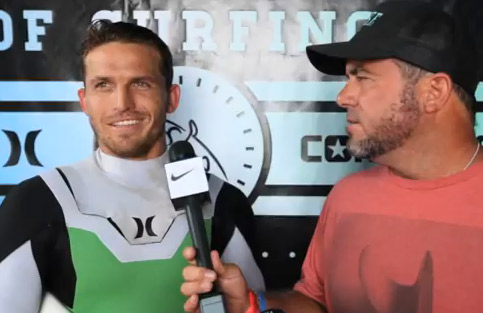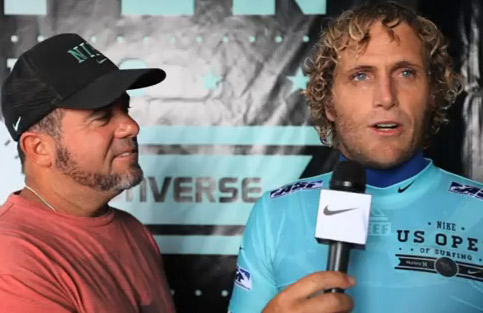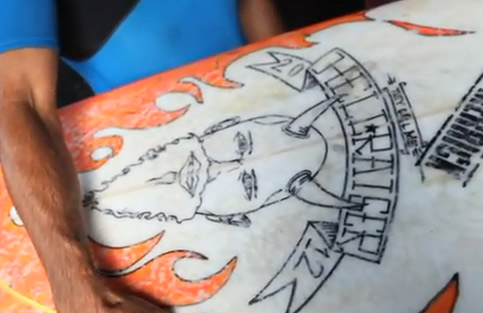3rd June
Phil Edwards
Phillip (“Phil”) Edwards (born June 10, 1938) is a legendary surfer. He is credited with being the first to surf the Banzai pipeline in Hawaii, being the first professional surfer, and creating the first signature surf board. He was the subject of a cover story, and his photo appeared on the cover of Sports Illustrated in 1966. Edwards was also featured prominently in the Bruce Brown films The Endless Summer and before that Surfing Hollow Days which featured the first film footage of Pipeline.
KEY: O= Original, R= Repaired, RF= Refurbished. Condition of board rated: 1(worst)-10(best)
Board Dimensions
Length: 7′ 0″
Width: 20″ 1/2
Thickness: 2″ 1/2
A classic Phil Edwards Honolulu Transitional 1968 with a classic glassed in flex fin. Some sun tanning on deck. A great example of the short board … Read More »
31st May
Wayne Lynch
Described by some as the inventor of vertical surfing and others as the ultimate soul surfer, Wayne Lynch’s contributions to the evolution of wave riding are hard to deny. He was a teenager during the critical transition from longboards to shortboards in the late sixties and early seventies. The lines he drew on early shortboards were completely new at the time and his influence can still be seen in today’s surfers.
Wayne began surfing at age 10 and was something of a child phenom in Australia. He won six consecutive Victoria state titles in the juniors division and four straight juniors division Australian national titles. He tried professional surfing for a short time and appeared in some notable surf films along the way, including a breakout performance in the 1969 release Evolution, the 1971 classic Sea of Joy and a 1978 … Read More »
28th May
Rick Rasmussen
The last world-class surfer to come out of the Big Apple was Rick Rasmussen in the seventies. He became known first for his bold tube riding at Pipeline, then for getting busted with a kilo of coke in Bali. He was eventually shot dead in the streets of Harlem in a deal gone bad.
KEY: O= Original, R= Repaired, RF= Refurbished. Condition of board rated: 1(worst)-10(best)
Board Dimensions
Length: 6′ 7″
Width: 19″ 1/2
Thickness: 3″
True East Coast Collectable. Rare find and in excellent all original condition. A Rick Rasmussen 1970’s Hand Shaped Pintail. Red Pigment deck overlap with a resin black pin line. Very white foam bottom with very little sun UV exposure. Rick R. R.I.P.. I have seen one other Rick … Read More »
26th May
Mark Foo
Life and career
Born in Singapore to Chinese photojournalists for the U.S. Information Agency he relocated to Hawaii at age 10. Foo spent his early childhood surfing the South Shore of O’ahu. His family moved several times during his adolescence, but Foo ultimately returned to Hawaii just before finishing high school. He continued surfing throughout his teen years and in 1977 he joined a professional surfing tour, the IPS World Tour. In the early 1980s, Foo quit the IPS World Tour, stopped competing, and began surfing Waimea Bay, a famous big wave surfing spot on the North Shore of O’ahu. Foo’s passion for surfing big waves led him to surf larger and larger swells.
Accidental Death at Maverick’s
On December 23, 1994, Mark Foo died in a surfing accident at Mavericks, a big wave in Half Moon Bay, Northern California. Surfer magazine wrote that … Read More »
24th May
Martin Potter
Martin Potter (born October 28, 1965), nicknamed “Pottz” and “Eggy Potter”, is a British born, former surfing professional who was educated in Durban, South Africa. He began surfing off the beaches of his hometown Durban at age 10. By the age of 15, he was surfing 20″+ waves at the infamous “Banzai Pipeline” located on Hawaiis North Shore. At the time, he was using the assistance of jet-ski to tow into the wave as an alternative to paddling. This pre-dated modern tow-in surfing and can help lay claim to Potter being one of ‘tow-in’ surfings pioneers. Potter won theAssociation of Surfing Professionals (ASP) World Championship Tour in 1989 after claiming 6 tour victories from 25 events scheduled for that years title race, and therefore the title of “World Surfing Champion,”. This would come fourteen years after learning to … Read More »
16th May
Bing
Bing Copeland played a major role in helping surfing and the surfboard industry to become what they are today. At 13, he became fascinated while helping out at pioneer surfboard maker Dale Velzy’s workshop in Manhattan Beach. He spent the mid-’50s in the Coast Guard stationed in Hawaii and surfed the big waves of Oahu’s North Shore and Makaha. In 1958 he sailed across the Pacific and introduced modern surfboards to New Zealand. By 1960, back in Southern California, he was making surfboards commercially and his company became one of the longest-running and most progressive in the surfing world. This is the story of Bing Copeland, the business he built, the colorful cast of craftsmen he employed and the visionary surfboards they made and continue to make even now.
KEY: O= Original, R= Repaired, RF= Refurbished. … Read More »
18th April
Donald Takayama
At 65, Donald Takayama is still going strong. He started his career of making boards at age 11, became a shaper, surfer and still proves to be the master of style and technique. Takayama discusses his board designs, quality, and craftsmanship which led him to the aloha spirit of manufacturing. He muses over his innovations and high performance surfboards, and the reasons why he continues to create boards which he personally engineers from choice of wood on to the entire production process.
KEY: O=Original, R= Repaired, RF= Refurbished. Condition of board rated: 1(worst)-10(best)
Board Dimensions
Length: 6′ 8″
Width: 19″ 1/2
Thickness: 2″ 7/8
1970’s M.T.B. Bolt Airbrush
Purchased this as a Art Piece for my house. But, I soon realized after my acquisition I … Read More »
14th April
Hot Buttered
Never anything but individual, Terry Fitzgerald emerged at the start of surfing’s true pro era — the ’70s — and played a key role in finally pushing high performance way clear of the sport’s longboarding roots and into the realm of the power carve. In his prime, he’s represented the peak example of the “total surfer” — a man who could ride any wave, anywhere, on his own equipment, without compromise.
Back in Australia, Fitzgerald carried his design thoughts into Hot Buttered, working with the super-hot performance school at North Narrabeen. Surfers and shapers who passed through his factory over the years include Simon Anderson, Col Smith, Derek Hynd, Steve Wilson, Greg Day, Greg Webber and many more. Along with their unique design twists, his boards became famous for the airbrush spray work of Martin Worthington, … Read More »
9th April
Local Motion
Since 1977 Local Motion has been committed to perpetuating the surfing lifestyle. That means designing and building technically advanced products from surfboards to surf clothing to keep you surfing to the best of your ability. Surfing is all about having fun and we’re dedicated to providing you all the tools so that your life can revolve around it.
KEY: O= Original, R= Repaired, RF= Refurbished. Condition of board rated: 1(worst)-10(best)
Board Dimensions
Length: 8′ 3″
Width: 19″
Thickness: 2″ 1/4
Bobby Digital OC Acquisition. Reported as Derrick Ho’s personal rider in the early 90’s late 80’s. This board was shaped for the North Shore. Unknown on actual year. Signature Camouflage deck spray. Foam glassed in fins. All original , great buy. … Read More »
7th April
Morey-Pope
Tom Morey and Karl Pope first met in classes at the University of Southern California in the mid ’50s. Tom graduated with a degree in Mathematics in 1958 and went to work for Douglas Aircraft. In 1964 he left corporate life to open Tom Morey Surfboards. In 1965 he invited Karl to join him and Morey-Pope Surfboards was founded.
Over the next five years Morey-Pope would prove to be a profoundly influential force in the surf industry. In addition to surfboard models like the Snub, Peck Penetrator, Blue Machine and Camel, they introduced products like Slipcheck and W.A.V.E. Set. Slipcheck was an aerosol alternative to surfboard wax. W.A.V.E. Set became the first commercially successful removable fin system.
In 1970 the partnership ended, but not until after the two college buddies had left a lasting impression … Read More »













